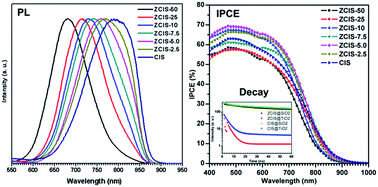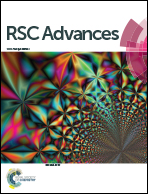Zinc dopant inspired enhancement of electron injection for CuInS2 quantum dot-sensitized solar cells†
Abstract
After being doped with zinc, CuInS2 quantum dots (QDs) exhibit desired tunable optical and electronic properties, more specifically, photoluminescence emission and band gap. The former is mainly due to the intrinsic donor–acceptor transition, which, together with the improved quantum yield and large longest decay time, accounts for 95% of the whole emission profiles. The latter results in an enhanced ket value of 2.99 × 1010 s−1, greater than that for pure CuInS2 QDs by an order of magnitude. Functioning as light harvesting materials in quantum dot sensitized solar cells, zinc doped CuInS2 QDs show broadened photoresponse up to ∼950 nm. Incident photon-to-current conversion efficiency of quantum dot sensitized solar cells achieves a maximum of 69% at 500 nm and can be maintained over 50% within the window below 750 nm. After the doping with zinc under optimized conditions, the average power conversion efficiency of solar cells under one full sun illumination demonstrates an increase of 13.2%, from 5.21% for pure CuInS2 QDs to 5.90% for doped CuInS2 QDs. It is proven that the improved performance can be attributed to a broadened optoelectronic response range and accelerated electron injection.



 Please wait while we load your content...
Please wait while we load your content...